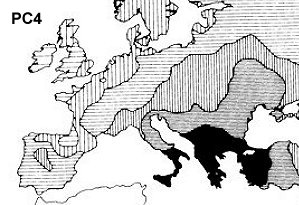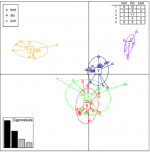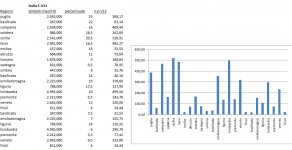Angela
Elite member
- Messages
- 21,823
- Reaction score
- 12,329
- Points
- 113
- Ethnic group
- Italian
The data is largely consistent with my points. Although it's very, very limited & doesn't have a lot of eastern data, Lecce V-13 is almost double that of Sicily in the west (15% in Lecce). The average E-V13 in Sicily is roughly 8%, which was sort of my point (& interestingly, lower than what you find in the north of Italy. So if you're arguing the north of Italy reduced the percentage of E-V13, that doesn't really add up.). E on the whole does not go up from west to east, but E-V13 does. Same is true south to north. Western Italy is marked by a significantly larger proportion of other E types (probably indicating movement of peoples from North Africa & the Levant), a signature which is smaller in the east & the north.
Plus or minus 800 years. LOL. Also, I really don't buy it. If E-V13 has been in southern Europe 7-8000 years (It has. Spanish cave.), my guess is that it has been in Italy (particularly eastern Italy adjacent to Balkans) roughly the same amount of time. The TMRCA estimates are notoriously inaccurate. However, it is possible that the E-V13 in this study (from Sicily) is somewhat younger than that found in the east of Italy & is connected to Greek colonization in antiquity. But anyone who thinks all that V-13 in the east of Italy is from 2000 yrs ago or so, rather than from Cardium Pottery & other pre-historic migrations, I think is arguing from a pretty tenuous position. I think that is extremely unlikely. But as stated, some of the V13 settlement in the west of Italy could be more recent. However, I suspect much of the E-V13 in the east of Italy goes back 5000 yrs or more.
Did you even look at the Sarno et al tables? They're not at all consistent with your points. To save your argument you're now comparing one town in Puglia to all of western Sicily. That's not at all a fair comparison. If you actually look at the table, Lecce, one town in Puglia in mainland Italy, has 15% E-V13, but Trapani, one town in far northwest Sicily has 14.71% or approximately 15%.
Plus, as I said, we're talking about an average of 11% versus an average of 14%. I don't see the big deal here. Plus, as I said, that difference is easily explained by later demographic movements into both Sicily and southern Italy. I don't at all understand your statement that northern Italian migration into Sicily could not have diluted E-V13. First of all, you are not defining Northern Italy correctly. Second of all, the northern Italian migration into Sicily was primarily from Lombardia, hence why it's called the Lombard migration, and the dialects some of the towns founded by them still speak are called the Lombard Sicilian dialects. Where do you find more E-V13 in Lombardia or the Veneto than in southern Italy? I suggest you take a look at Table S2 in Boattini et al, and compute how much E-V13 they show in Lombardia.
http://journals.plos.org/plosone/article?id=10.1371/journal.pone.0065441/#s6
Also, I don't know if you're aware of it, but there are documented movements of Greek speakers into southern Puglia in the Middle Ages. That's one of the reasons it's still the largest Griko speaking area in Italy. We're talking about further waves into that area, but it doesn't negate that there were first millennium BC movements into all of Magna Graecia. I also don't know where you find all these large percentages of "other" "E" in western Italy. Again, please check the data tables. The data doesn't show that at all.
View attachment 8180
Sarno at all concentrating on southern Italy and Sicily:
View attachment 8181
Not that the late first millennium BC movement of Greek speakers into Italy is the only such movement. I think we'll find that not only trade but people flowed into Italy, along the Adriatic coast, in particular, during the Mycenaean era.
Actually, I don't understand what larger point you're trying to make here. If it's about E-V13 in general, then there are other countries with much more of it that have to be understood. If it's about the issue of Greek migration into Italy, E-V13 is not the only lineage that has to be considered.
As for dating the E-V13 migrations to Europe, it's true that we've found the precursors in Neolithic samples. We also know, however, that the expansion is dated to the Bronze Age. I think a strong argument could be made that most E-V13 is going to descend from that period of expansion. The expansion is also centered in the Balkans, so any E-V13 in Italy is likely to have an ultimate Balkan origin. I'd also point out that +or- 800 years from 300 BC is not going to take you back to the Neolithic. However, until E-V13 gets the same kind of attention that some R1b clades received, a lot of this is just speculation.








